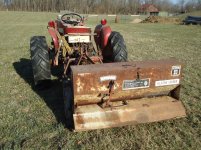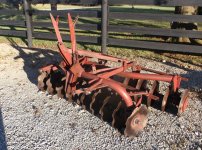Egon
Epic Contributor
That looks really good!!
"Use what you have", has always been my mantra, but the way I redo pastures and old fields is to use a turning plow and turn the soil over throughout the entire field. Then I attach a cable to the widest, biggest log I can pull SIDEWAYS and drag that through the field. The longer that log is, the smoother the field is because it fills and cuts over a wider swath. Of course the heavier it is, the less the log rides up over hummocks and has more dirt it fill the dips. It takes quite a few passes, but the more you drive over the field, alternating directions like going lengthways, then diagonal, then legthways again, really makes for a nice field. This method also pushes rocks into the soil. I usually pick any of the bigger rocks that the log fails to push down, then make a final pass with the sideways log to smooth things up.
To sow down, I use a trailer with a homemade broadcaster. Using a U-Bolt, I connect a 1/2 inch drill to the trailer, then put my portable generator on the trailer and power the drill with that. To broadcast the seed, I use a length of threaded rod bolted to the top of a 5 gallon bucket where 2 pieces of angle iron are bolted to act as vanes. As my wife drives the tractor and attached trailer, I scoop into the seed with a coffee can and shake it onto the spinning homemade broadcaster.
Last year I did a 10 acre field using this method and it worked well. Again not saying the way you did so was wrong as it obviously wasn't, but just saying that a person only has to use what they have creatively to get a good result!
(The first photo shows the end result, a field of clover/timothy and oats. The second shows the homemade broadcaster, and the third shows me pulling a log sideways to really smooth the field up. A skidder is not required, I just happen to have it and it could pull a heavy, longer log).
That seeder is neat. Logs work well for levelling.

